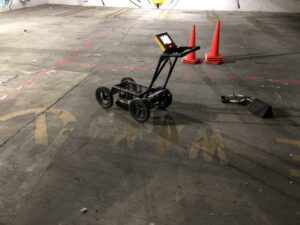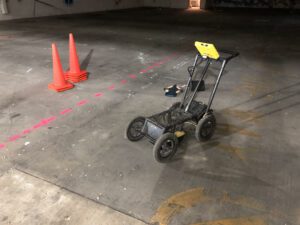In the realm of construction, particularly where underground work is involved, safety and accuracy are paramount. This is where Dig Alert and Ground Penetrating Radar (GPR) come into play, serving as vital tools for any excavation project. Understanding and utilizing these technologies not only enhance safety but also ensures compliance with environmental and legal standards, particularly in the context of methane emission concerns.
Understanding the Role of Dig Alert
 Dig Alert acts as a preemptive measure to secure safety in excavation projects. This essential service alerts utility companies to mark underground utilities before digging starts. It helps to prevent catastrophic errors like severing gas lines or electrical cables. In areas where subterranean methane is a concern, this service becomes even more critical. Disturbed methane can create not only physical dangers but also significant environmental damage.
Dig Alert acts as a preemptive measure to secure safety in excavation projects. This essential service alerts utility companies to mark underground utilities before digging starts. It helps to prevent catastrophic errors like severing gas lines or electrical cables. In areas where subterranean methane is a concern, this service becomes even more critical. Disturbed methane can create not only physical dangers but also significant environmental damage.
Additionally, Dig Alert plays a key role in broader environmental safety practices. As urban areas expand, the underground landscape becomes increasingly crowded with utilities and potential hazards such as methane pockets. Dig Alert provides essential information that helps shape effective safety measures to manage these risks.
The Growing Importance of Methane Mitigation in Excavation
Implementing robust methane mitigation strategies in urban and industrial areas is crucial. Methane, a potent greenhouse gas, can pose explosive risks and contribute to air pollution if not managed properly. Excavation activities may disturb these gas pockets, leading to dangerous releases unless proactive measures are in place.
Integrating Dig Alert into methane mitigation is critical. By identifying buried utilities, Dig Alert also indirectly flags areas where methane could be present. This integration allows for targeted methane tests and the implementation of mitigation designs early in the project planning phase. Such planning ensures that all necessary safety precautions are in place.
How Dig Alert Enhances Methane Safety Measures
Beyond marking utility locations, Dig Alert supports comprehensive methane safety strategies by integrating with environmental monitoring practices. When utility companies respond to a Dig Alert notification, they can also provide information on known methane hazards. This allows for a more informed approach to excavation and construction activities.
This information is crucial for designing effective methane mitigation systems. For instance, if engineers identify a high-risk methane area, they can incorporate advanced venting systems or barriers. These systems prevent gas migration during and after excavation. They are vital for maintaining safe work environments and minimizing environmental impact, highlighting Dig Alert’s role in proactive environmental management.
Ground Penetrating Radar (GPR) – A Complementary Technology
 GPR complements the safety measures provided by Dig Alert by offering a detailed view of the underground. This technology excels at detecting non-metallic objects and other anomalies that traditional utility marking might miss. These could include old, unrecorded pipelines or abandoned methane mitigation systems.
GPR complements the safety measures provided by Dig Alert by offering a detailed view of the underground. This technology excels at detecting non-metallic objects and other anomalies that traditional utility marking might miss. These could include old, unrecorded pipelines or abandoned methane mitigation systems.
Moreover, GPR’s non-invasive nature allows for thorough pre-construction assessments without disturbing the site. This capability is invaluable in planning excavations near sensitive areas where methane pockets or other hazardous materials may be present. By providing detailed maps of underground structures, GPR enables precise planning and reduces the likelihood of encountering unforeseen obstacles.
The Role of GPR in Methane Mitigation Strategies
GPR is instrumental in refining methane mitigation efforts by identifying exact locations of underground anomalies that could indicate methane. These detailed scans allow for the precise placement of mitigation infrastructure. Such measures as gas extraction wells or impermeable barriers are then optimally located to manage methane risks effectively.
Furthermore, GPR can track the effectiveness of existing methane mitigation systems by monitoring changes in the underground environment over time. This ongoing assessment helps ensure that systems continue to function as intended and adapt to new conditions. It provides a continuous shield against methane-related hazards in urban construction sites.
The Synergy Between Dig Alert and GPR in Methane-Rich Environments
Dig Alert and GPR work together to ensure comprehensive coverage for safe excavation, especially crucial in methane-rich areas. When Dig Alert notifies utility companies to mark underground lines, this process also involves checking for possible methane hazards. This allows for preemptive mitigation measures. GPR complements this by offering precise, real-time verification of underground structures, including old methane containment systems or uncharted natural gas pockets.
Accurate Marking for Methane Safety
The accuracy of utility marking provided by Dig Alert is enhanced by GPR’s ability to detail the underground landscape. This combined approach not only identifies utility lines but also potential methane sources, which could pose significant risks if disturbed. By confirming the exact position of these hazards, the chances of accidentally striking a methane pocket are minimized, ensuring a safer excavation process.
Enhanced Methane Safety Measures
Utilizing both Dig Alert and GPR maximizes safety by detecting both marked utilities and unmarked methane hazards. This dual detection system is crucial in areas known for methane emissions, as it helps prevent incidents like gas leaks or explosions. Enhanced safety measures protect workers and the community, ensuring that methane mitigation strategies are effectively implemented before and during the excavation.
Cost Efficiency through Methane Risk Management
Avoiding damage to utilities and disrupting methane pockets significantly reduces potential project delays, fines, and extensive repair costs associated with methane management mishaps. Investing in both GPR and Dig Alert protocols allows contractors to proceed with confidence. This reduces costly errors and legal liabilities associated with methane disturbances.
Key Benefits of Dig Alert and GPR in Methane Mitigation
The integration of Dig Alert’s utility location data with GPR’s detailed subsurface mapping substantially reduces risks during excavations in methane-prone areas. This synergy not only ensures greater safety but also aids in the precise implementation of methane mitigation strategies.
Improved Methane Management
By effectively combining Dig Alert and GPR, contractors are better equipped to handle methane risks, thereby enhancing safety for all nearby residents and workers. This extensive approach allows for the early detection and management of methane, crucial for preventing potential accidents and ensuring environmental safety.
Legal Compliance in Methane Regulations
In regions where methane presence is known, compliance with safety and environmental regulations is critical. Dig Alert and GPR ensure that all potential methane hazards are identified and managed according to legal standards, protecting contractors from penalties and enhancing their reputation for responsible construction practices.
Faster Project Completion with Reduced Methane Risks
Knowledge of the exact locations of both utilities and methane hazards helps project managers to efficiently plan excavations, avoiding unforeseen delays caused by methane-related issues. This clarity and foresight promote faster, safer project completion, benefiting the entire community.
Conclusion: Towards a Safer and More Sustainable Future
As the demand for urban space continues to grow, so does the complexity of its infrastructure. Dig Alert and GPR stand out as critical tools for navigating this complexity safely and responsibly. They not only safeguard human lives and existing utilities but also play a significant role in environmental stewardship by managing methane emissions effectively. Embracing these technologies represents a step towards more sustainable and conscientious construction practices, ensuring safety and efficiency as cities continue to evolve.
Sources
“About DigAlert.” DigAlert.Org – California’s Underground Utility Location Services, www.digalert.org/about.
“DigAlert – California Law.” DigAlert.Org – California Law, www.digalert.org/calaw.
